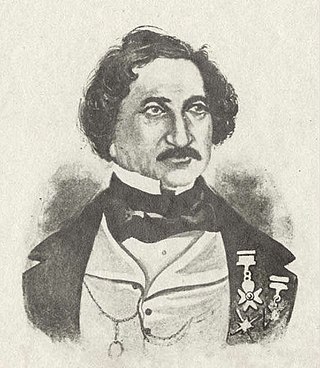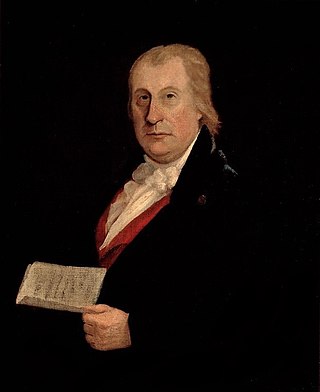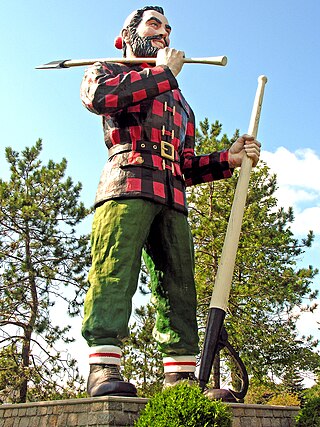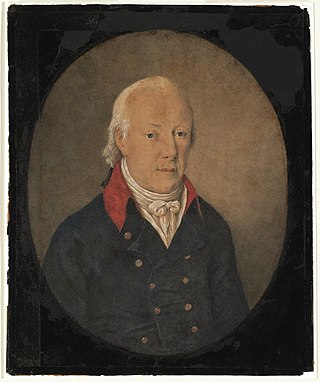
Emmet County is a county located in the U.S. state of Michigan. It is the northernmost county in the Lower Peninsula. As of the 2020 census, the population was 34,112, making it the second-most populous county in Northern Michigan. The county seat is Petoskey, which is also the county's largest city.

Alexander Henry 'The Elder', in French: Alexandre Henri Le Vieux was an American-born explorer, author, merchant who settled in Quebec following the Conquest of New France and was a partner in the North West Company and a founding member and vice-chairman of the Beaver Club. From 1763 to 1764, he lived and hunted with Wawatam of the Ojibwe, who had adopted him as a brother.

Fort Michilimackinac was an 18th-century French, and later British, fort and trading post at the Straits of Mackinac; it was built on the northern tip of the lower peninsula of the present-day state of Michigan in the United States. Built around 1715, and abandoned in 1783, it was located along the Straits, which connect Lake Huron and Lake Michigan of the Great Lakes of North America.
Michilimackinac is derived from an Ottawa Ojibwe name for present-day Mackinac Island and the region around the Straits of Mackinac between Lake Huron and Lake Michigan. Early settlers of North America applied the term to the entire region along Lakes Huron, Michigan, and Superior. Today it is considered to be mostly within the boundaries of Michigan, in the United States. Michilimackinac was the original name for present day Mackinac Island and Mackinac County.

The siege of Detroit, also known as the surrender of Detroit or the Battle of Fort Detroit, was an early engagement in the War of 1812. A British force under Major General Isaac Brock with indigenous allies under Shawnee leader Tecumseh used bluff and deception to intimidate U.S. Brigadier General William Hull into surrendering the fort and town of Detroit, Michigan, along with his dispirited army which actually outnumbered the victorious British and Indians.

John Richardson was a Canadian officer in the British Army who became the first Canadian-born novelist to achieve international recognition.
Robert Hamilton was a businessman, judge and political figure in Upper Canada.
John Askin (1739–1815) was an Anglo-Irish fur trader, merchant, and colonial official. He was instrumental in the establishment of British rule in Upper Canada.

The siege of Fort of Mackinac was one of the first engagements of the War of 1812. A British and Native American force captured the island soon after the outbreak of war between Britain and the United States. Encouraged by the easy British victory, more Native Americans rallied to their support. Their cooperation was an important factor in several British victories during the remainder of the war.
Joseph Bailly was a fur trader and a member of an important French Canadian family that included his uncle, Charles-François Bailly de Messein.

Magdelaine La Framboise (1780–1846), born Marguerite-Magdelaine Marcot, was one of the most successful fur traders in the Northwest Territory of the United States, in the area of present-day western Michigan. Of mixed Odawa and French descent, she was fluent in the Odawa, French, English and Ojibwe languages of the region, and partnered with her husband. After he was murdered in 1806, she successfully managed her fur trade business for more than a decade, even against the competition of John Jacob Astor. After retiring from the trade, she built a fine home on Mackinac Island.
L'Arbre Croche, known by the Odawa people as Waganagisi, was a large Odawa settlement in Northern Michigan. The French called it L'Arbre Croche for the large crooked tree that marked the center of the settlement and was visible for many miles. It covered the region from Harbor Springs to Cross Village in present-day Emmet County, Michigan.

Isaac Todd was one of Montreal's most prominent merchants following the British Conquest of New France and a founding member of the Beaver Club at Montreal and the Canada Club at London. He was one of the earliest partners in the North West Company before it was formalized, but was better known for his partnership with James McGill. In 1812, he purchased Buncrana Castle in Inishowen, County Donegal, which he left to his nephew, William Thornton-Todd, the younger brother of Andrew Todd.

Sainte Anne Church is a Roman Catholic church located in the city of Mackinac Island in the U.S. state of Michigan.
John Askin Jr. (c1765–1820) was a merchant in the Great Lakes fur trade, officer in the British Indian Department, and government official in Upper Canada and Michigan. He and his wife, Madelaine, are remembered as being instrumental in the invention of the Mackinaw jacket in 1811.
The History of slavery in Michigan includes the pro-slavery and anti-slavery efforts of the state's residents prior to the ratification of the Thirteenth Amendment to the United States Constitution in 1865.

The mackinaw jacket, also known as a mackinaw coat, is a short double-breasted coat made of a thick heavy woollen material, generally with a red-and-black plaid pattern.

Colonel Daniel Robertson was an officer in the British Army in North America, commandant of the British post at Michilimackinac, and a landowner in Chatham Township, Canada. Born in Scotland, he first joined the 42nd Regiment of Foot, also known as the "Black Watch," and was present at the British capture of Montreal in 1760, as well as the invasion of Martinique in 1762. During the American Revolutionary War, he was an officer in the 84th Regiment of Foot, another regiment of Scots known as the Royal Highland Emigrants. In 1779, he was appointed commandant of Fort Osgewatchie and oversaw Native American raids on American settlements on the Mohawk River.
Panis was a term used for slaves of the First Nations descent in Canada, a region of New France. First Nation slaves were generally called Panis, with most slaves of First Nations descent having originated from Pawnee tribes. The term later became synonymous with "Indian slave" in the French colony, with a slave from any tribe being called Panis.
Nissowaquet was an Odawa leader of the Nassauakueton doodem. His father was chief Returning Cloud Kewinaquot and his mother was Nesxesouexite Neskes Mi-Jak-Wa-Ta-Wa. He grew up in Michilimackinac and moved 20 miles (32 km) to L'Arbre Croche with around 180 warriors in 1741.











